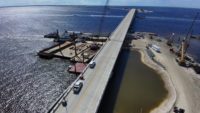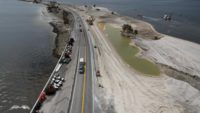Permanent repairs to the roadway portion of the Sanibel Causeway are substantially complete one year and four months after more than 6,000 Sanibel Island residents lost access to the mainland in the wake of Hurricane Ian. The Superior Construction and The De Moya Group joint-venture team, responsible for the work, say that all travel lanes are now permanently open to the island off Florida's southwest coast near Fort Myers.
“We’ve substantially completed the permanent roadway repairs, which include everything inside the white edge lines of the roadway,” say Superior Division Manager Ryan Hamrick and Superior Area Manager Toby Mazzoni in a joint response to ENR.
In October 2022, 15 days of emergency work by Superior Construction and Ajax Paving made it possible for the causeway to reopen. On Sept. 8, 2023, phase 2 began under Superior Construction and The de Moya Group, with the priority of further shoring up the roadway and protecting the causeway from future storms, which will be the focus of the next year.
The scope of work, which Mazzoni says in a statement would normally take 18 or more months to complete, took 105 days. The project leaders attribute this speed to “phased design-build” which enables concurrent design and construction activities. While the Superior-de Moya JV team was completing the emergency work in October 2022, they were already meeting with the Florida Dept. of Transportation (FDOT) to discuss design and construction for the next phase.
To complete the road rebuild, the Sanibel team demolished 35,000 sq yd of existing roadway asphalt and base, 2,270 linear ft of concrete barrier wall and 4,500 linear ft of concrete coping and five bridge approach slab areas, according to a statement. The roadway was also elevated 2 ft.
The team is now focusing on work beyond the roadway shoulders, including resiliency measures, and the team says Lee County is working with FDOT to restore the island parks and reopen the nearby boat ramp.
FDOT has approved a design for resiliency measures including elevating the seawall 3 ft to protect the causeway from storm surges. On the ocean side, the seawall will be reinforced with layers of heavy armoring stone to provide scour protection and wave break.
The bridge approaches, some of which collapsed during the storm, will be reinforced with a deep foundation steel king pile wall system — in lieu of mechanically stabilized earth (MSE) walls — which allows water to escape through an underdrain system.
“Nearly all of the MSE wall systems failed on the Sanibel causeway,” say Hamrick and Mazzoni. “The various steel sheet pile wall systems are believed to prevent these same types of failures from occurring in the future.”
The causeway roadway will be protected with a buried steel sheet pile wall system which is capped with a concrete bulkhead and reinforced with a buried marine mattress and riprap stone. Sand was added on top to preserve the natural beach appearance.
The Sanibel resiliency features were designed based on data collected after Hurricane Ian hit the causeway. Each causeway varies in how it may react to a storm, say project leaders, which is why it’s critical to look at each on a case-by-case basis.
Hamrick and Mazzoni anticipate that despite the road elevation, water could still flow over the causeway in a storm comparable to Hurricane Ian. “But, due to all of these resiliency features, access won’t be cut off.”



